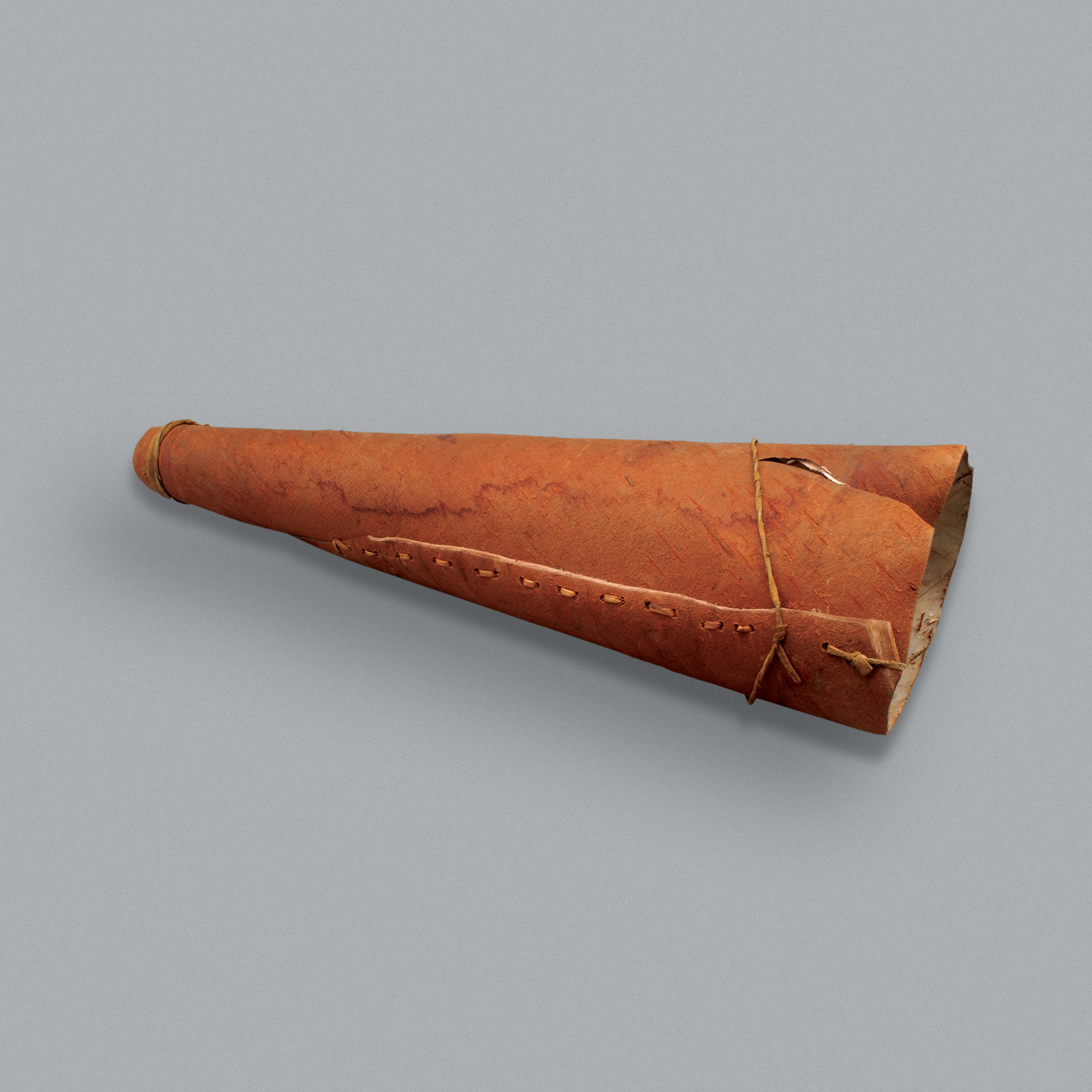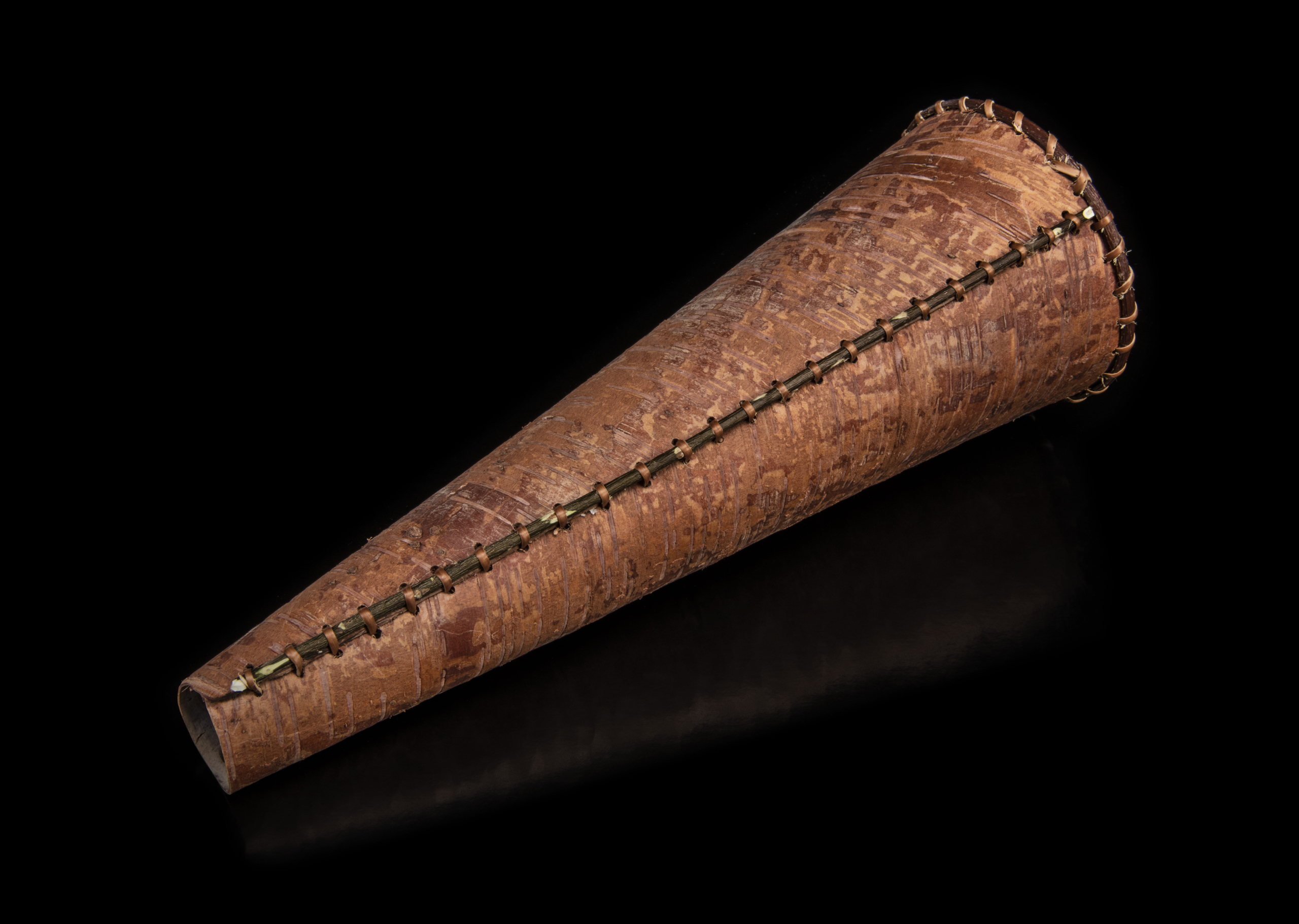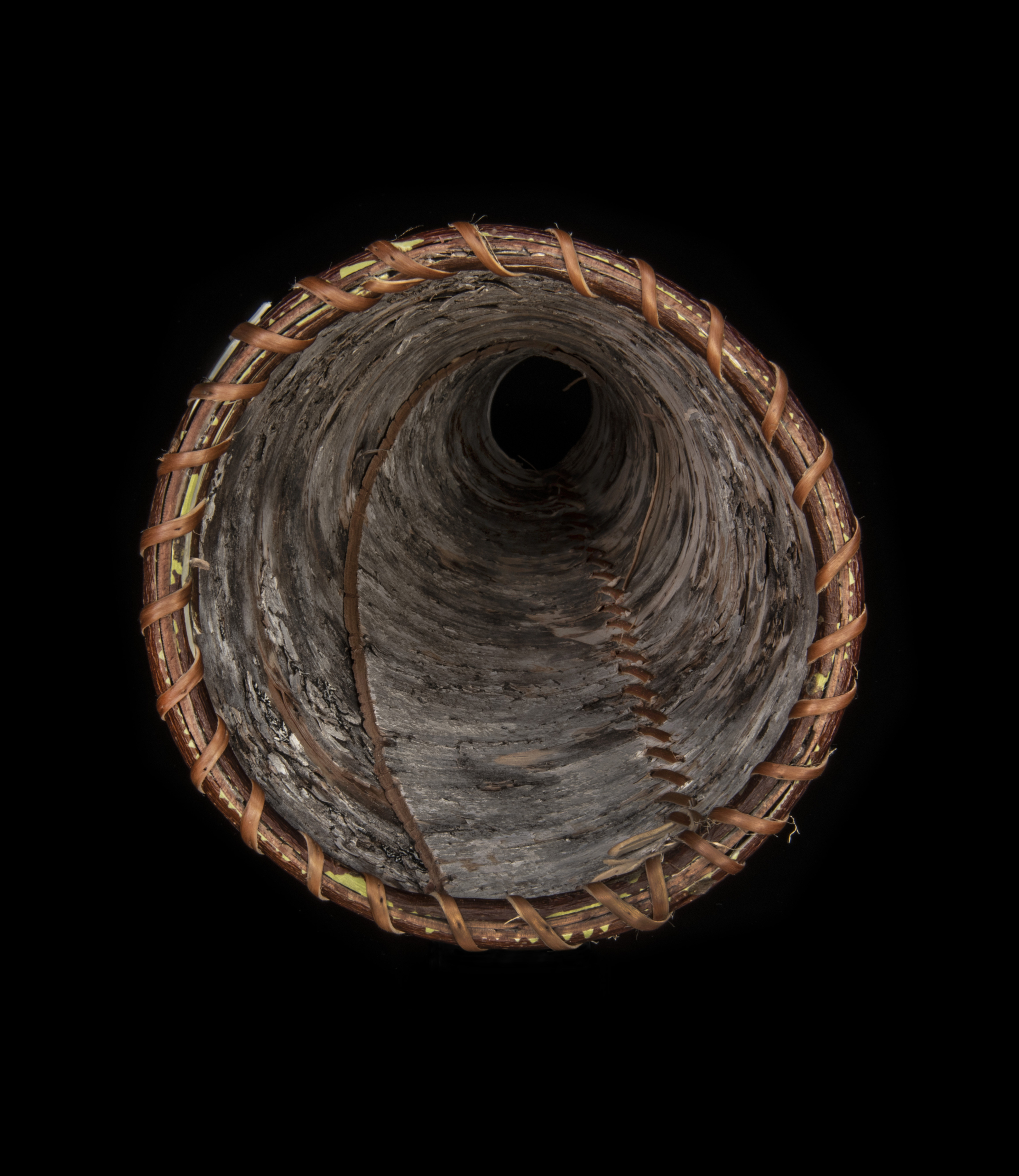Moose Call
Artifact
Image
Video
Audio
 Activities
Activities
LOOK
Look closely at this object. What do you think it is used for? Verify your answer by reading the Historical Context below.
LOOK
What materials is this object made of? Where would you find these materials?
Details
 Materials
Materials - Spruce Roots
- Birchbark
- Rawhide
Historical Context
Choose one of the three levels below to match your needs.
- This is a moose call. It is used to attract moose during the hunt. Blowing air through it makes a sound like a moose.
- Throughout the Eastern Woodlands, First Peoples moved along rivers and coastlines as the seasons changed, hunting, fishing and gathering resources as they became available.
- Birchbark moose calls are so effective that they continue to be made and sold for use by moose hunters today.
Scroll through the media carousel above to see two images of the moose call found in the History Box and watch an interview with the artist who made it: Todd Labrador, Mi’kmaq elder.
A moose call is used to attract moose during the hunt. Blowing air through it makes a sound like a moose. This example is made of birchbark, spruce root and rawhide.
Throughout the Eastern Woodlands, First Peoples moved along rivers and coastlines as the seasons changed, hunting, fishing and gathering resources as they became available. Deer, caribou, moose and beaver were important sources of food.
While calls may differ in their materials, with some being made from basswood bark, silver birchbark and moose bone, as well as in the designs they feature, the basic construction of the calls is the same. Birchbark moose calls are so effective that they continue to be made and sold for use by moose hunters today.
A moose call is used to attract moose during the hunt. Blowing air through the cone makes a sound like a moose. This example is made of birchbark, spruce root and rawhide.
Throughout the Eastern Woodlands, First Peoples lived in birchbark lodges or wigwams within small, multi-family villages. They moved along rivers and coastlines as the seasons changed, hunting, fishing and gathering resources as they became available. Deer, caribou, moose and beaver were important sources of food. Moose hunting was especially important in Anishinaabe (Algonquin) culture.
The Canadian Museum of History has several different moose calls in its collections, from Maliseet, Algonquin, Southern Tutchone and Innu cultures. Although the calls may differ in materials — basswood bark, silver birchbark and even moose bone — as well as in design, the basic construction of the calls is the same.
Birchbark moose calls are so effective that they continue to be made and sold for use by moose hunters today. The moose call in this kit was made by Todd Labrador, a Mi’kmaq Elder and artist who lives in Nova Scotia.
- This is a moose call. It is used to attract moose during the hunt. Blowing air through it makes a sound like a moose.
- Throughout the Eastern Woodlands, First Peoples moved along rivers and coastlines as the seasons changed, hunting, fishing and gathering resources as they became available.
- Birchbark moose calls are so effective that they continue to be made and sold for use by moose hunters today.
Scroll through the media carousel above to see two images of the moose call found in the History Box and watch an interview with the artist who made it: Todd Labrador, Mi’kmaq elder.
A moose call is used to attract moose during the hunt. Blowing air through it makes a sound like a moose. This example is made of birchbark, spruce root and rawhide.
Throughout the Eastern Woodlands, First Peoples moved along rivers and coastlines as the seasons changed, hunting, fishing and gathering resources as they became available. Deer, caribou, moose and beaver were important sources of food.
While calls may differ in their materials, with some being made from basswood bark, silver birchbark and moose bone, as well as in the designs they feature, the basic construction of the calls is the same. Birchbark moose calls are so effective that they continue to be made and sold for use by moose hunters today.
A moose call is used to attract moose during the hunt. Blowing air through the cone makes a sound like a moose. This example is made of birchbark, spruce root and rawhide.
Throughout the Eastern Woodlands, First Peoples lived in birchbark lodges or wigwams within small, multi-family villages. They moved along rivers and coastlines as the seasons changed, hunting, fishing and gathering resources as they became available. Deer, caribou, moose and beaver were important sources of food. Moose hunting was especially important in Anishinaabe (Algonquin) culture.
The Canadian Museum of History has several different moose calls in its collections, from Maliseet, Algonquin, Southern Tutchone and Innu cultures. Although the calls may differ in materials — basswood bark, silver birchbark and even moose bone — as well as in design, the basic construction of the calls is the same.
Birchbark moose calls are so effective that they continue to be made and sold for use by moose hunters today. The moose call in this kit was made by Todd Labrador, a Mi’kmaq Elder and artist who lives in Nova Scotia.
Summary
- This is a moose call. It is used to attract moose during the hunt. Blowing air through it makes a sound like a moose.
- Throughout the Eastern Woodlands, First Peoples moved along rivers and coastlines as the seasons changed, hunting, fishing and gathering resources as they became available.
- Birchbark moose calls are so effective that they continue to be made and sold for use by moose hunters today.
Scroll through the media carousel above to see two images of the moose call found in the History Box and watch an interview with the artist who made it: Todd Labrador, Mi’kmaq elder.
Essential
A moose call is used to attract moose during the hunt. Blowing air through it makes a sound like a moose. This example is made of birchbark, spruce root and rawhide.
Throughout the Eastern Woodlands, First Peoples moved along rivers and coastlines as the seasons changed, hunting, fishing and gathering resources as they became available. Deer, caribou, moose and beaver were important sources of food.
While calls may differ in their materials, with some being made from basswood bark, silver birchbark and moose bone, as well as in the designs they feature, the basic construction of the calls is the same. Birchbark moose calls are so effective that they continue to be made and sold for use by moose hunters today.
In-Depth
A moose call is used to attract moose during the hunt. Blowing air through the cone makes a sound like a moose. This example is made of birchbark, spruce root and rawhide.
Throughout the Eastern Woodlands, First Peoples lived in birchbark lodges or wigwams within small, multi-family villages. They moved along rivers and coastlines as the seasons changed, hunting, fishing and gathering resources as they became available. Deer, caribou, moose and beaver were important sources of food. Moose hunting was especially important in Anishinaabe (Algonquin) culture.
The Canadian Museum of History has several different moose calls in its collections, from Maliseet, Algonquin, Southern Tutchone and Innu cultures. Although the calls may differ in materials — basswood bark, silver birchbark and even moose bone — as well as in design, the basic construction of the calls is the same.
Birchbark moose calls are so effective that they continue to be made and sold for use by moose hunters today. The moose call in this kit was made by Todd Labrador, a Mi’kmaq Elder and artist who lives in Nova Scotia.



